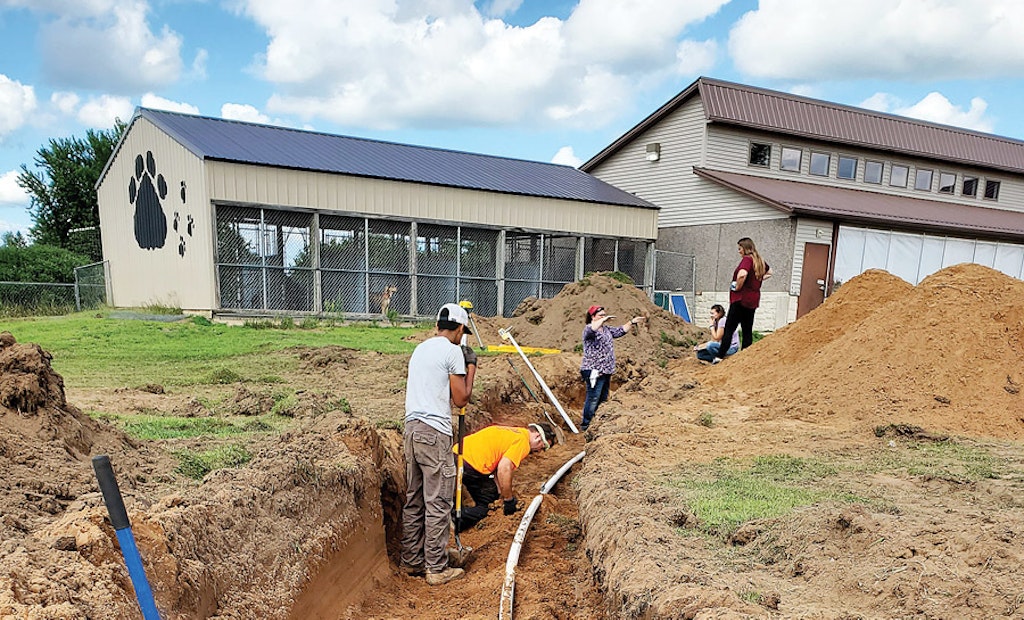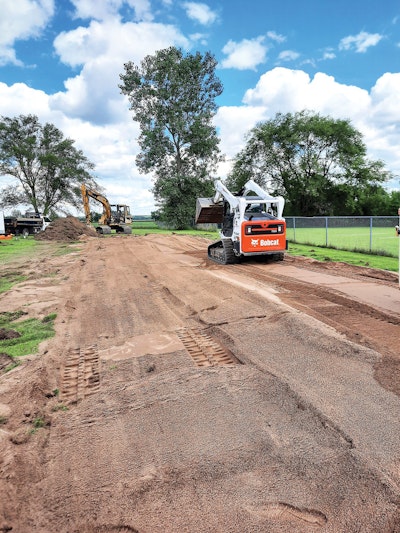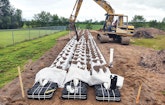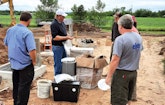
Brady Rubenzer, left, and Mark Yohnk, second from left, both of Stolt Excavating, CeCe Rudnicki of the Wisconsin Department of Safety and Professional Services, second from right, and Lindsey O’Rourke and Haillie Passow of Chippewa County Planning & Zoning, right, install the 100 feet of force main taking wastewater from the treatment chain to the Eljen GSF drainfield at the Chippewa Humane Association. (Photos courtesy of Joe Rubenzer)
The call came late in fall 2019 from the Chippewa County Humane Association in northern Wisconsin. The onsite system at the animal shelter was failing, and they asked Joe Rubenzer at Stolt Excavating & Trucking in Chippewa Falls, if his company could install a new drainfield.
Rubenzer agreed to look at the situation, but first he pulled the county’s sanitary records. They said two drainfields had been installed on the property in the previous 15 years.
“I said, ‘You guys have something else going on here. I think we need to look into this deeper,’” Rubenzer recalls.
He contacted Mark Prevost at First Supply in nearby Eau Claire, Wisconsin, for a second opinion. Together they met with people from the animal welfare organization to talk about how much water they were using. The answer was quite a bit.
“They’re doing laundry daily, multiple loads, washing bedding for the animals,” Rubenzer says. They were deep-cleaning kennels and generally using more water than the 450-gpd system was designed to process.
As part of their investigation, Rubenzer and Prevost had a meter installed on the system and watched it for a couple of months. On days when the shelter was open, use averaged 754 to 1,015 gpd.
On days when the shelter was closed, when the staff is cleaning, average water use varied from 1,208 to 1,432 gpd.
At that point, Rubenzer told the humane association they would be better off upgrading the system. Fortunately for the nonprofit group, Prevost is passionate about animals, and Rubenzer said he went to work on the phone seeking equipment donations. The result was a system that meets the association’s needs with newer technology and extra filtration.
Lots of filters
From the humane association’s building, effluent leaves in two ways and in two amounts and is treated in a five-tank system.
On the north side of the building, the lesser amount of wastewater from the indoor kennels moves through a 4-inch Schedule 40 pipe to a 2,000-gallon, two-chamber tank from Crest Precast of La Crescent, Minnesota. This tank replaces a holding tank in the same area.
Water settles in the 1,250-gallon first chamber and flows through a Polylok 525 filter into the 750-gallon second chamber. A SJE Rhombus reed switch trips an alarm if the Polylok filter is clogged and water is backing up. In the second chamber, a Goulds PE51 pump controlled by an SJE Rhombus data logging panel sends wastewater through a Sim/Tech STF-100 filter and into 200 feet of 2-inch force main that circles the building and joins a 4-inch Schedule 40 pipe receiving the larger amount of wastewater on the south side. Pumping was the only solution, Rubenzer says. The grade wasn’t right for a gravity feed, and the wastewater flow couldn’t be rerouted.
The 4-inch pipe enters the first tank in a four-tank treatment chain. Tank one is a 1,000-gallon concrete model from Huffcutt Concrete in Chippewa Falls. It was already in place, and Rubenzer repurposed it. It also has a Polylok 525 filter and SJE Rhombus reed on the outlet.
Tanks two through five are new concrete models from Crest Precast.
Tank two is a 2,000-gallon two-chamber model. Combined with tank one, this tank provides flow equalization, and the two chambers allow for more settling and provide the opportunity to install more filters to deal with animal hair, Rubenzer says. At the inlet of the 1,250-gallon first chamber in tank two, Rubenzer and his technicians installed a piece of perforated rigid pipe that can be filled with crushed limestone to adjust pH. A Polylok 625 filter separates the first chamber from the second 750-gallon chamber. On the outlet of the second chamber is a manifold with four Sim/Tech STF-110 bristle filters.
All the filters are not overkill. When Rubenzer and Prevost met with the humane association representatives, they also took a look at the drainfield. “It was full of hair,” Rubenzer says. “You could tell some cat litter had gone through.”
In tank three (3,000 gallons) is a White Knight MIG WK150 from Knight Treatment Systems. Its blower is located in a storage section of the building’s garage, and most of the system alarms are also located there.
A standard baffle separates tank three from tank four (2,000 gallons), which doses the absorption field. Dual Goulds WE0721H pumps push water through two Sim/Tech STF 100A2 pressure filters and then through about 100 feet of 2-inch force main to the field. Another SJE Rhombus data logging panel controls this part of the system.
The field is built from 300 feet of Eljen GSF modules split into three rows. The entire drainfield cell is 9 feet wide by 109 feet long. Wastewater is distributed through 2-inch PVC pipe inside 4-inch perforated pipe. Modules were laid on 12 inches of sand and topped with about another foot of sand and topsoil.
Teaching tool
Installation went smoothly, Rubenzer says. Stolt workers, and a couple of volunteers, used Cat 313 and 312 excavators, a John Deere 35C mini-excavator, and a Bobcat T595 skid-steer to put the system in the ground.
There was a small hill the crew cut into to build the drainfield, and the rest was on level ground.
Because so much equipment was donated, Rubenzer says, the association could have a system with more filters than would be typical and the Eljen GSF system allowed a smaller drainfield footprint.
Rubenzer had never worked with Eljen or Knight Treatment Systems equipment, so he spent the winter before the project doing a lot of research and visiting an area restaurant with a White Knight system in place.
As part of the project, Rubenzer donated a part of Stolt’s fees. CeCe Rudnicki, of the Wisconsin Department of Safety and Professional Services, used the project as a teaching tool for county workers and sanitarians, and people showed up throughout the five-day project to observe, Rubenzer says.
Other donors were: Cresline Pipe, Eljen, Goulds Water Technology, Knight Treatment Systems, Polylok, Premier Plumbing, SJE Rhombus, Sim/Tech Filter and Stelter. And other people stopped in to donate time.
All the donations resulted in a system that cost the humane association about half of what a commercial customer would pay, Rubenzer says. “I know if we would have come to them with the original price, there’s no way they could have afforded it.”










